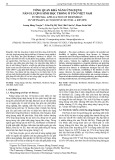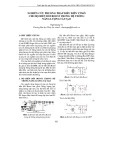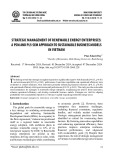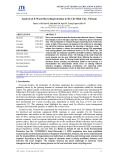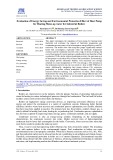
114
HNUE JOURNAL OF SCIENCE
Natural Sciences 2024, Volume 69, Issue 3, pp. 114-127
This paper is available online at http://hnuejs.edu.vn/ns
DOI: 10.18173/2354-1059.2024-0041
PREPARATION OF CONDUCTIVE MEMBRANES BY CHEMICAL IN SITU
POLYMERIZATION OF POLYPYRROLE ON CELLULOSE FIBERS
Tran Duc Dong, Dao Duc Tung, Bui Hoang Van, Nguyen Dinh Quang,
Bui Dinh Tu, Vu Thi Thao and Nguyen Duc Cuong*
VNU University of Engineering and Technology, Vietnam National University,
Hanoi city, Vietnam
*Corresponding author: Nguyen Duc Cuong, e-mail address: cuongnd@vnu.edu.vn
Received June 12, 2024. Revised October 26, 2024. Accepted October 31, 2024.
Abstract. The development of flexible electronic devices, particularly flexible and
bendable energy storage devices, has catalyzed significant interest in the research of
flexible composite materials. In this study, conductive paper membranes were
synthesized by polymerizing polypyrrole (PPy) on the surface of cellulose fibers.
The cellulose material, derived from cardboard, underscores an eco-friendly
approach to waste reduction and environmental protection. Characterization of the
cellulose/PPy conductive membranes using Fourier-transform infrared spectroscopy
(FT-IR), field-emission scanning electron microscopy (FE-SEM), and differential
scanning calorimetry (DSC) confirmed the formation and uniform coverage of PPy
on the cellulose surface. To enhance the uniformity of PPy polymerization on
cellulose relative to previous studies, this work focuses on elucidating the formation
and deposition of PPy particles on cellulose fibers, leading to the development of a
homogeneous membrane. The membrane exhibited a peak electrical conductivity of
18.04 mS/cm at 0.1 mA, with conductivity increasing alongside PPy concentration,
albeit at the expense of mechanical properties. Additionally, the membrane
demonstrated charge storage capability, with specific capacitance values ranging
from 22.5 to 50 pF/cm2 at a frequency of 1 kHz. The uniformity of PPy coverage on
the cellulose surface was a crucial factor influencing the electrical properties of the
composite membrane. This research highlights the significant potential of conductive
membranes for application in flexible and bendable energy storage devices.
Keywords: cellulose fiber, flexible, polymerization, polypyrrole.
1. Introduction
In recent years, significant research has focused on green materials, emphasizing the
use of biodegradable and environmentally friendly polymers for energy storage devices
[1]-[3]. These polymers are sustainable, recyclable, flexible, lightweight, and capable of
easily interacting with other materials to form composites with exceptional properties [4], [5].







